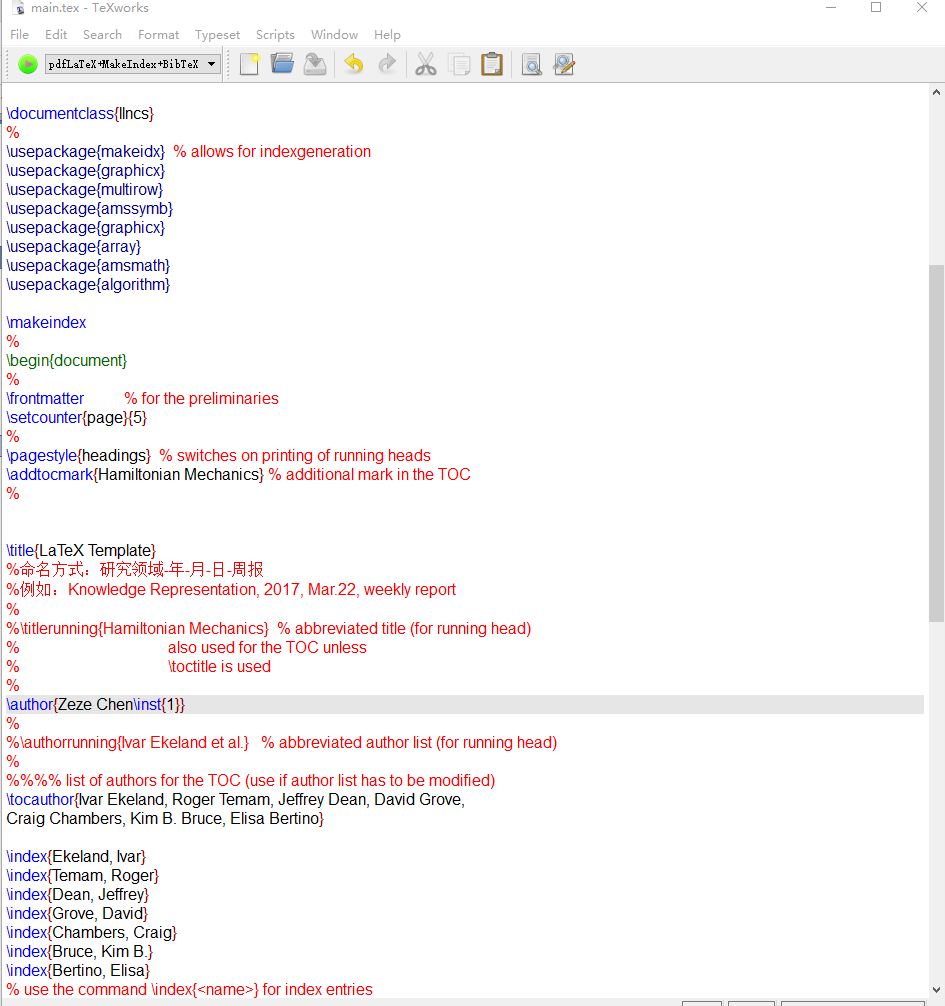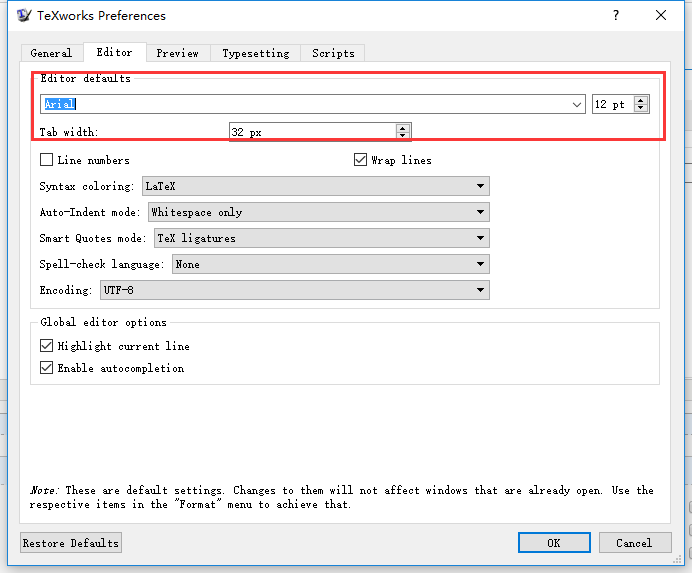LaTeX是当今世界上最流行和使用最为广泛的 TeX格式。它构筑在 Plain TeX的基础之上,并加进了很多的功能以使得使用者可以更为方便的利用 TeX的强大功能。使用 LaTeX基本上不需要使用者自己设计命令和宏等,因为 LaTeX已经替你做好了。
一、下载安装
下载地址:

二、数学公式
1、数学公式的前后要加上 $ 或 \( 和 \)
比如:$f(x) = 3x + 7$ 和 \(f(x) = 3x + 7\) 效果是一样的; 如果用 \[ 和 \],或者使用 $$ 和 $$,则该公式独占一行; 如果用 \begin{equation} 和 \end{equation},则公式除了独占一行还会自动被添加序号, 如何公式不想编号则使用 \begin{equation*} 和 \end{equation*}.
2、字符
普通字符在数学公式中含义一样,除了# $ % & ~ _ ^ \ { } 若要在数学环境中表示这些符号# $ % & _ { },需要分别表示为\# \$ \% \& \_ \{ \},即在个字符前加上\。
3、上标和下标
用 ^ 来表示上标,用 _ 来表示下标,看一简单例子:
$$\sum_{i=1}^n a_i=0$$ $$f(x)=x^{x^x}$$
效果:
这里有更多的
4、希腊字母
更多请参见
5、数学函数
例如sin x, 输入应该为\sin x
6、在公式中插入文本可以通过 \mbox{text} 在公式中添加text
比如:
\documentclass{article} \usepackage{CJK} \begin{CJK*}{GBK}{song} \begin{document} $$\mbox{对任意的$x>0$}, \mbox{有 }f(x)>0. $$ \end{CJK*} \end{document}
效果:
7、分数及开方
\frac{numerator}{denominator} \sqrt{expression_r_r_r}表示开平方,
\sqrt[n]{expression_r_r_r} 表示开 n 次方.8、省略号(3个点)
\ldots 表示跟文本底线对齐的省略号;\cdots 表示跟文本中线对齐的省略号,
比如:
表示为 $$f(x_1,x_x,\ldots,x_n) = x_1^2 + x_2^2 + \cdots + x_n^2 $$
9、括号和分隔符
() 和 [ ] 和 | 对应于自己;{} 对应于 \{ \};|| 对应于 \|。 当要显示大号的括号或分隔符时,要对应用 \left 和 \right,如:
\[f(x,y,z) = 3y^2 z \left( 3 + \frac{7x+5}{1 + y^2} \right).\]对应于
\left. 和 \right. 只用与匹配,本身是不显示的,比如,要输出:
则用 $$\left. \frac{du}{dx} \right|_{x=0}.$$
10、多行的数学公式
可以表示为:
\begin{eqnarray*} \cos 2\theta & = & \cos^2 \theta - \sin^2 \theta \\ & = & 2 \cos^2 \theta - 1. \end{eqnarray*}
其中&是对其点,表示在此对齐。*使latex不自动显示序号,如果想让latex自动标上序号,则把*去掉
11、矩阵
表示为:
The \emph{characteristic polynomial} $\chi(\lambda)$ of the $3 \times 3$~matrix \[ \left( \begin{array}{ccc} a & b & c \\ d & e & f \\ g & h & i \end{array} \right)\] is given by the formula \[ \chi(\lambda) = \left| \begin{array}{ccc} \lambda - a & -b & -c \\ -d & \lambda - e & -f \\ -g & -h & \lambda - i \end{array} \right|.\]
c表示向中对齐,l表示向左对齐,r表示向右对齐。
12、导数、极限、求和、积分(Derivatives, Limits, Sums and Integrals)
The expression_r_r_rs
are obtained in LaTeX by typing
\frac{du}{dt} and \frac{d^2 u}{dx^2}
respectively. The mathematical symbol is produced using \partial. Thus the Heat Equation
is obtained in LaTeX by typing
\[ \frac{\partial u}{\partial t} = h^2 \left( \frac{\partial^2 u}{\partial x^2} + \frac{\partial^2 u}{\partial y^2} + \frac{\partial^2 u}{\partial z^2}\right)\]
To obtain mathematical expression_r_r_rs such as
in displayed equations we type \lim_{x \to +\infty}, \inf_{x > s} and \sup_K respectively. Thus to obtain
(in LaTeX) we type
\[ \lim_{x \to 0} \frac{3x^2 +7x^3}{x^2 +5x^4} = 3.\]
Added by Goldman2000@126:-------------------------
To compulsively display "u \to \infty" under the limit,

we type in LaTeX
\frac{1}{\lim_{u \rightarrow \infty}}, \frac{1}{\lim\limits_{u \rightarrow \infty}} or
\frac{1}{ \displaystyle \lim_{u \rightarrow \infty}} respectively.
Ended by Goldman2000@126: -------------------------
To obtain a summation sign such as
we type \sum_{i=1}^{2n}. Thus
is obtained by typing
\[ \sum_{k=1}^n k^2 = \frac{1}{2} n (n+1).\]
We now discuss how to obtain integrals in mathematical documents. A typical integral is the following:
This is typeset using
\[ \int_a^b f(x)\,dx.\]
The integral sign is typeset using the control sequence \int, and the limits of integration (in this case a and b are treated as a subscript and a superscript on the integral sign.
Most integrals occurring in mathematical documents begin with an integral sign and contain one or more instances of d followed by another (Latin or Greek) letter, as in dx, dy and dt. To obtain the correct appearance one should put extra space before the d, using \,. Thusand
are obtained by typing
\[ \int_0^{+\infty} x^n e^{-x} \,dx = n!.\] \[ \int \cos \theta \,d\theta = \sin \theta.\] \[ \int_{x^2 + y^2 \leq R^2} f(x,y)\,dx\,dy = \int_{\theta=0}^{2\pi} \int_{r=0}^R f(r\cos\theta,r\sin\theta) r\,dr\,d\theta.\]
and
\[ \int_0^R \frac{2x\,dx}{1+x^2} = \log(1+R^2).\]
respectively.
In some multiple integrals (i.e., integrals containing more than one integral sign) one finds that LaTeX puts too much space between the integral signs. The way to improve the appearance of of the integral is to use the control sequence \! to remove a thin strip of unwanted space. Thus, for example, the multiple integral
is obtained by typing
\[ \int_0^1 \! \int_0^1 x^2 y^2\,dx\,dy.\]
Had we typed
\[ \int_0^1 \int_0^1 x^2 y^2\,dx\,dy.\]
we would have obtained
A particularly noteworthy example comes when we are typesetting a multiple integral such as
Here we use \! three times to obtain suitable spacing between the integral signs. We typeset this integral using
\[ \int \!\!\! \int_D f(x,y)\,dx\,dy.\]
Had we typed
\[ \int \int_D f(x,y)\,dx\,dy.\]
we would have obtained
The following (reasonably complicated) passage exhibits a number of the features which we have been discussing:
One would typeset this in LaTeX by typing In non-relativistic wave mechanics, the wave function $\psi(\mathbf{r},t)$ of a particle satisfies the \emph{Schr\"{o}dinger Wave Equation} \[ i\hbar\frac{\partial \psi}{\partial t} = \frac{-\hbar^2}{2m} \left( \frac{\partial^2}{\partial x^2} + \frac{\partial^2}{\partial y^2} + \frac{\partial^2}{\partial z^2} \right) \psi + V \psi.\] It is customary to normalize the wave equation by demanding that \[ \int \!\!\! \int \!\!\! \int_{\textbf{R}^3} \left| \psi(\mathbf{r},0) \right|^2\,dx\,dy\,dz = 1.\] A simple calculation using the Schr\"{o}dinger wave equation shows that \[ \frac{d}{dt} \int \!\!\! \int \!\!\! \int_{\textbf{R}^3} \left| \psi(\mathbf{r},t) \right|^2\,dx\,dy\,dz = 0,\] and hence \[ \int \!\!\! \int \!\!\! \int_{\textbf{R}^3} \left| \psi(\mathbf{r},t) \right|^2\,dx\,dy\,dz = 1\] for all times~$t$. If we normalize the wave function in this way then, for any (measurable) subset~$V$ of $\textbf{R}^3$ and time~$t$, \[ \int \!\!\! \int \!\!\! \int_V \left| \psi(\mathbf{r},t) \right|^2\,dx\,dy\,dz\] represents the probability that the particle is to be found within the region~$V$ at time~$t$.
三、在线公式编辑器

四、Miktex模板
% This is LLNCSDE2.TEX, a variation of LLNCS.DEM% (the demonstration file of% the LaTeX macro package from Springer-Verlag% for Lecture Notes in Computer Science,% version 2.3 for LaTeX2e),% which can be used by volume editors for the preparation% of the front matter pages and the author index%% Last changes: 16.10.2006, Frank Holzwarth (texhelp@springer.de)%%%%%%%%%%%%%%%%%%%%%%%%%%%%%%%%%%%%%%%%%%%%%%%%%%%%%%%%%%%%%%%%%%%%%%% In order to generate an Author Index do the following:% After TeXing this document start the program MakeIndex by typing% MAKEINDX -S SPRMINDX.STY% (generates an IND file for the Author Index)% into the DOS command line.% (At other systems you may have to use the command MAKEINDEX.)% Now TeX this file once again, then you will get an Author Index.% TeX this file once more, then the TOC will be complete.%%%%%%%%%%%%%%%%%%%%%%%%%%%%%%%%%%%%%%%%%%%%%%%%%%%%%%%%%%%%%%%%%%%%%\documentclass{llncs}%\usepackage{makeidx} % allows for indexgeneration\usepackage{graphicx}\usepackage{multirow}\usepackage{amssymb}\usepackage{graphicx}\usepackage{array}\usepackage{amsmath}\usepackage{algorithm}\makeindex%\begin{document}%\frontmatter % for the preliminaries\setcounter{page}{5}%\pagestyle{headings} % switches on printing of running heads\addtocmark{Hamiltonian Mechanics} % additional mark in the TOC%\title{LaTeX Template}%命名方式:研究领域-年-月-日-周报%例如:Knowledge Representation, 2017, Mar.22, weekly report%%\titlerunning{Hamiltonian Mechanics} % abbreviated title (for running head)% also used for the TOC unless% \toctitle is used%\author{Zeze Chen\inst{1}}%%\authorrunning{Ivar Ekeland et al.} % abbreviated author list (for running head)%%%%% list of authors for the TOC (use if author list has to be modified)\tocauthor{Ivar Ekeland, Roger Temam, Jeffrey Dean, David Grove,Craig Chambers, Kim B. Bruce, Elisa Bertino}\index{Ekeland, Ivar}\index{Temam, Roger}\index{Dean, Jeffrey}\index{Grove, David}\index{Chambers, Craig}\index{Bruce, Kim B.}\index{Bertino, Elisa}% use the command \index{ } for index entries%\institute{Princeton University, Princeton NJ 08544, USA,\\\email{I.Ekeland@princeton.edu},\\ WWW home page:\texttt{http://users/\homedir iekeland/web/welcome.html}}\maketitle % typeset the title of the contribution\abstract{2017.3.22. \\ \textbf{Keyword:} XXX; XXX; XXX.}\section{First Paper}Well, it is just testing. I don't know what will happen...\begin{equation}e^{\pi{i}}+1=0\end{equation}\section{Second Paper}another testing...\begin{eqnarray*}\cos 2\theta & = & \cos^2 \theta - \sin^2 \theta \\& = & 2 \cos^2 \theta - 1.\end{eqnarray*}\section{Third Paper}testing...\begin{figure}\centering\includegraphics[width=0.5\textwidth]{fig.png} \caption{Test figure}\label{Figure name}\end{figure}\end{document}
五、默认字体设置
Preference->Editor
